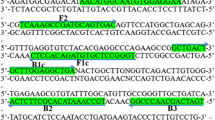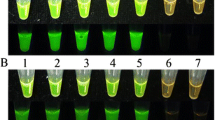Abstract
Fusarium asiaticum is an important fungal pathogen that causes wheat head blight or scab in China. In this study, we describe a loop-mediated isothermal amplification assay that directly detects F. asiaticum in diseased wheat head tissues, thus allowing rapid diagnosis of wheat head blight caused by this pathogen. We selected the CYP51C gene sequence to design loop-mediated isothermal amplification (LAMP) primers specific for F. asiaticum. The target gene (CYP51C) was efficiently amplified in 60 min at 63 °C using the LAMP assay. The sensitivity of the assay was 100 pg·μL−1. Specificity was compared with those for other Fusarium spp. and other fungal species. The result was directly visualized by adding hydroxynaphthol blue prior to amplification; a color change (sky blue) was observed only in the presence of F. asiaticum, whereas all other isolates showed no color change. We successfully applied the LAMP assay to diagnose the suspected disease in wheat head samples collected in the field. This study provides a new tool for the diagnosis of Fusarium head blight caused by F. asiaticum.


Similar content being viewed by others
References
Bockus WW, Bowden RL, Hunger RM, Morrill W, Murray T, Smiley R (2010) Compendium of wheat disease and pest, Third edn. The American Phytopathological Society, St. Paul, Minnesota
Bushnell WR, Hazen, BE, Pritsch C, Leonard KJ, Bushnell WR (2003) Histology and physiology of Fusarium head blight, pp 44–83
Desjardins AE (2007) Fusarium mycotoxins. Plant Pathol 56(2):337–337
Dong F, Qiu JB, Xu JH, Yu MZ, Wang SF, Sun Y, Zhang GF, Shi JR (2016) Effect of environmental factors on Fusarium population and associated trichothecenes in wheat grain grown in Jiangsu Province, China. Int J Food Microbiol 230:58–63
Fernández-Ortuño D, Waalwijk C, Van der Lee T, Fan J, Atkins S, West JS, Fraaije BA (2013) Simultaneous real-time PCR detection of Fusarium asiaticum, F. ussurianum and F. vorosii, representing the Asian clade of the F. graminearum species complex. Int J Food Microbiol 166(1):148–154
Erwin DC, Ribeiro OK (1996) Phytophthora diseases worldwide. The American Phytopathological Society, St. Paul
Gale LR, Chen LF, Hernick CA, Takamura K, Kistler HC (2002) Population analysis of Fusarium graminearum from wheat fields in eastern China. Phytopathology 92(12):1315–1322
Goswami RS, Kistler HC (2004) Heading for disaster: Fusarium graminearum on cereal crops. Mol Plant Pathol 5(6):515–525
Goto M, Honda E, Ogura A, Nomoto A, Hanaki K (2009) Colorimetric detection of loop-mediated isothermal amplification reaction by using hydroxynaphthol blue. BioTechniques 46(3):167–172
Notomi T, Okayama H, Masubuchi H, Yonekawa T, Watanabe K, Amino N, Hase T (2000) Loop-mediated isothermal amplification of DNA. Nucleic Acids Res 28(12):63–69
O’Donnell K, Kistler HC, Tacke BK, Casper HH (2000) Gene genealogies reveal global phylogeographic structure and reproductive isolation among lineages of Fusarium graminearum the fungus causing wheat scab. Proc Natl Acad Sci 97(14):7905–7910
O’Donnell K, Ward TJ, Geiser DM, Kistler HC, Aoki T (2004) Genealogical concordance between the mating type locus and seven other nuclear genes supports formal recognition of nine phylogenetically distinct species within the Fusarium graminearum clade. Fungal Genet Biol 41(6):600–623
O’Donnell K, Ward TJ, Aberra D, Kistler HC, Aoki T, Orwig N, Kimura M, Bjornstad A, Klemsdal SS (2008) Multilocus genotyping and molecular phylogenetics resolve a novel head bitght pathogen within the Fusarium gramineamm species complex from Ethiopia. Fungal Genet Biol 45(11):1514–1522
Qu B, Li HP, Zhang JB, Xu YB, Huang T, Wu AB, Zhao CS, Carter J, Nicholson P, Liao YC (2008) Geographic distribution and genetic diversity of Fusarium graminearum and Fusarium asiaticum on wheat spikes throughout China. Plant Pathol 57(1):15–24
Shi WQ, Yang LJ, Feng J, Zhang X, Zeng FS, Xiang LB, Wang H, Yu DZ (2011) Analysis on the population structure of Fusarium pathogenic spp. and its mycotoxin chemotypes in Fusarium head blight epidemic region. Phytopathology 41(5):486–494
Sikora K, Verstappen E, Mendes O, Schoen C, Ristaino J, Bonants P (2012) A universal microarray detection method for identification of multiple Phytophthora spp. using padlock probes. Phytopathology 102(6):635–645
Starkey DE, Ward TJ, Aoki T, Gale LH, Kistler HC, Geiser DM, Suga H, Tóth B, Varga J, O’Donnell K (2007) Global molecular surveillance reveals novel Fusarium head blight species and trichothecene toxin diversity. Fungal Genet Biol 44(11):1191–1204
Xu F, Yang GQ, Wang JM, Song YL, Liu LL, Zhang JJ (2016) Composition and variation in aggressiveness of Fusarium populations causing wheat head blight in Henan province. Phytopathology 46(3):294–303
Yang L, Van der Lee T, Yang X, Yu D, Waalwijk C (2008) Fusarium populations on Chinese barley show a dramatic gradient in mycotoxin profiles. Phytopathology 98(6):719–727
Yin Y, Liu X, Ma Z (2009) Simultaneous detection of Fusarium asiaticum and Fusarium graminearum in wheat seeds using a real-time PCR method. Soc Appl Microbiol 48(6):680–686
Zhang JB, Li HP, Dang FJ, Qu B, Xu YB, Zhao CS, Liao CS (2007) Determination of the triehothecene mycotoxin chemotypes and associated geographical distribution and phylogenetic species of the Fusarium graminearum clade from China. Mycol Res 111(8):967–975
Zhang H, Van der Lee T, Waalwijk C, Chen WQ, Xu J, Xu JS, Zhang Y, Feng J (2011) Population analysis of the Fusarium graminearum species complex from wheat in China shows a shift to more aggressive isolates. PLoS One 7(7):e31722
Zheng X (1995) Methods in Phytophthora. Chinese Agriculture Press, Beijing
Acknowledgements
This research was supported by grants of the National High-Tech R&D Program of China (863 Program: 2012AA101501) to Xiaobo Zheng, and the China Agriculture Research System (CARS-004-PS14) to Yuanchao Wang.
Author information
Authors and Affiliations
Corresponding author
Rights and permissions
About this article
Cite this article
Xu, M., Ye, W., Zeng, D. et al. Rapid diagnosis of wheat head blight caused by Fusarium asiaticum using a loop-mediated isothermal amplification assay. Australasian Plant Pathol. 46, 261–266 (2017). https://doi.org/10.1007/s13313-017-0487-y
Received:
Accepted:
Published:
Issue Date:
DOI: https://doi.org/10.1007/s13313-017-0487-y




